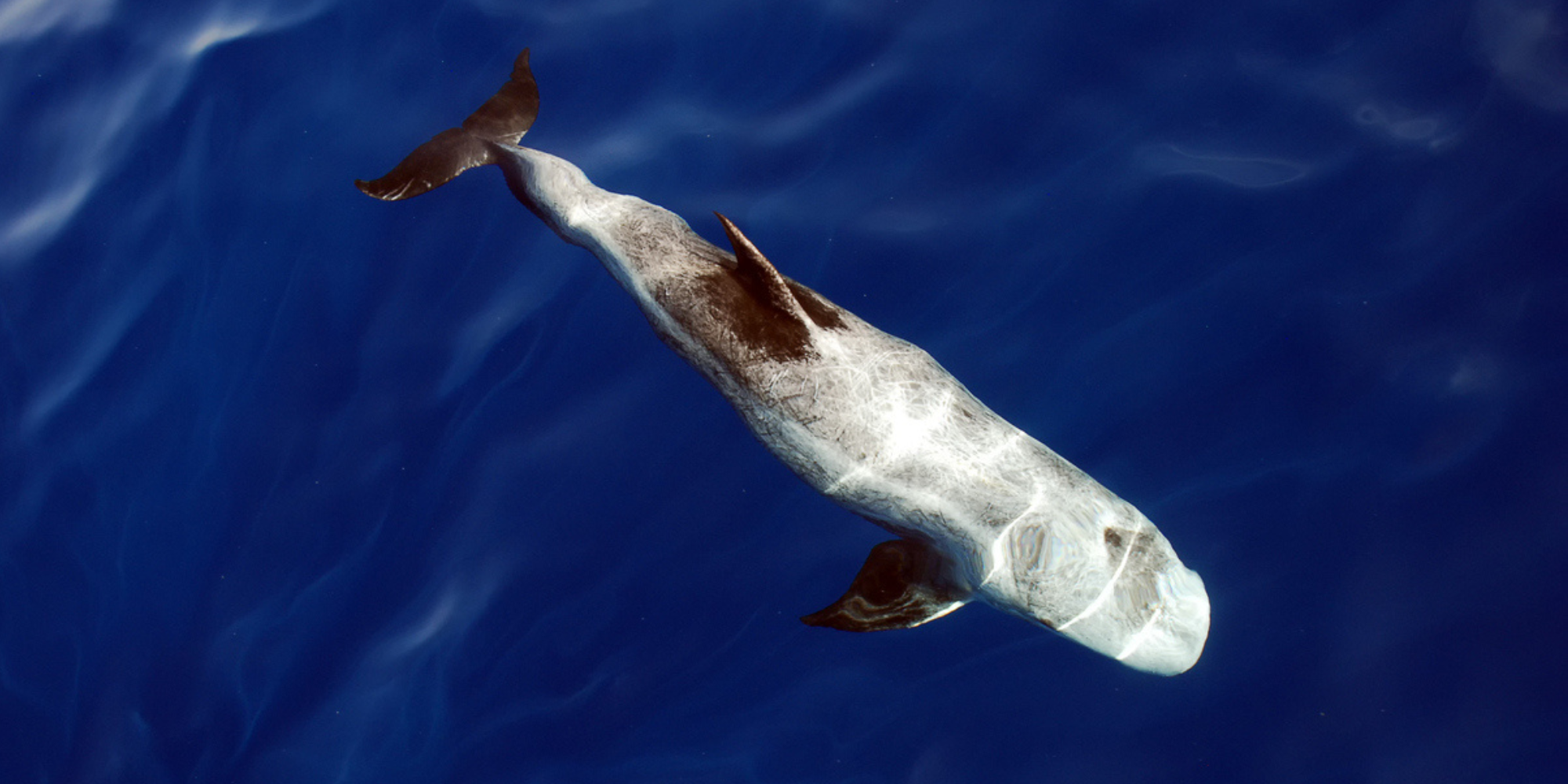Tending to inhabit deep offshore waters, Risso’s dolphins are the fifth largest member of the family Delphinidae and are sometimes called ‘grey dolphins’.
As they prefer deep water, Risso’s dolphins are relatively understudied (there are several places around the world where they’re found near the coast which has enabled research carried out to date).
The cetacean is named after a French-Italian naturalist called Antoine Risso who first described the species to renowned naturalist George Curvier in 1812.
Risso’s dolphins have a bulbous head, no discernible beak, elongated flippers and a tall curved dorsal fin.
Their colouration changes over their lifetime from dark grey to light grey or even white (check out this recent Newsweek article on a completely white Risso’s dolphin spotted off the Californian coast). As a Risso’s dolphin ages, it becomes paler.
Due to their prominent dorsal fin, Risso’s dolphins sometimes get mistaken for orca or white sharks when they’re spotted mostly underwater.
The species measures up to four metres in length and weighs in at up to 500 kilograms.
One distinctive feature of the species is that they’ve much fewer teeth compared to other cetaceans – they have between two and seven pairs of teeth in their lower jaw and usually none in their upper jaw.
Risso’s dolphins are noticeably scarred, either with scratches caused from teeth raking between dolphins or circular markings from prey such as squid, cookie-cutter sharks and lampreys.
The scarring contributes to the colour changes experienced over their lifetime.
The species is very active on the ocean’s surface, often leaping out of the water, spy hopping and slapping the pectoral fins or fluke on the water’s surface. Risso’s dolphins typically avoid boats but have been observed bow riding on occasion.
They also sometimes ‘porpoise’ which means moving in and out of the water in a series of fast leaps (most often when they’re being hunted by predators). They regularly dive down to around 300-500 metres and can hold their breath for up to 30 minutes.
Risso’s dolphins are usually found in groups of between 10 and 30 animals though they can also be found individually or in pairs. There are documented superpods of Risso’s dolphins with hundreds of animals gathering together.
With an estimated lifespan of at least 35 years, the Risso’s dolphin is listed as ‘Least Concern’ globally on the IUCN Red List of Threatened Species.
Studies are currently being carried out into Risso’s dolphins off the Balearic Islands by the Alnitak Research Institute. In 2021, the species’ IUCN status in the region was changed from ‘Data Deficient’ to ‘Endangered’.
You can read more about the research in this Discover Wildlife article from June 2023.

Where do Risso’s dolphins live?
The species is found worldwide in temperate, subtropical and tropical waters, preferring offshore waters (especially near the continental shelf edge). The dolphins are usually found in habitats from latitudes 64° North to 46° South.
In the Northern hemisphere, they’re found in regions including the Gulf of Alaska, Gulf of Mexico, Newfoundland, Norway, Japan, the Red Sea, Russia and the Azores.
They’re also found in the Mediterranean Sea, off the Canaries and are occasionally spotted off the UK and Irish coasts. In the Southern hemisphere, Risso’s dolphins are found in locations including Argentina, Chile, South Africa, New Zealand and Australia.
A Risso’s dolphin called Pelorus Jack became famous in New Zealand in the late 19th century. He was first noticed in 1888 awaiting boats near the entrance to Pelorus Sound, in the Marlborough Sounds, and he’d escort the ships travelling between Wellington and Nelson.
He often swam up against the boats and rode their bow waves.
Pelorus Jack did this for a long time – 24 years – and his fame grew with lots of people coming to see him. Read more about him in this Dolphin Project article.
What do they eat?
Risso’s dolphins love to eat squid but they’re also known to eat prawns, shrimp, cuttlefish, octopus and krill.
They mostly feed at night and usually suck in their food rather than biting it, which explains why they have relatively few teeth compared to other cetaceans.
Threats to Risso’s dolphins
Entanglement in fishing gear
Like other cetaceans, Risso’s dolphins can become entangled in fishing gear which goes on to cause injury, fatigue, comprised feeding and sometimes even death. Historically, Risso’s dolphins died in large numbers when they got caught up in purse seine nets along with tuna. Dolphin-safe tuna fishing practices have been implemented over the past few decades, helping to significantly reduce this impact.
Hunting
Risso’s dolphins are hunted for meat and oil off the coast of Japan (including the cove at Taiji) and several other countries around the world (Indonesia, the Lesser Antilles in the Caribbean, Sri Lanka and the Solomon Islands).
Environmental change and pollution
Climate change and pollution are a threat to all whales and dolphins because of the loss of habitat as waters become warmer.
Plastics and micro plastics, along with chemical pollutants, entering into the water system are a serious threat to all creatures in our ocean.
Risso’s dolphins, like other cetaceans, use noise to communicate and to locate prey. Increased noise pollution from vessels and other human activity interferes with this ability.
Natural predators
Orca have been observed preying on Risso’s dolphins and sharks are also predators of the species.



